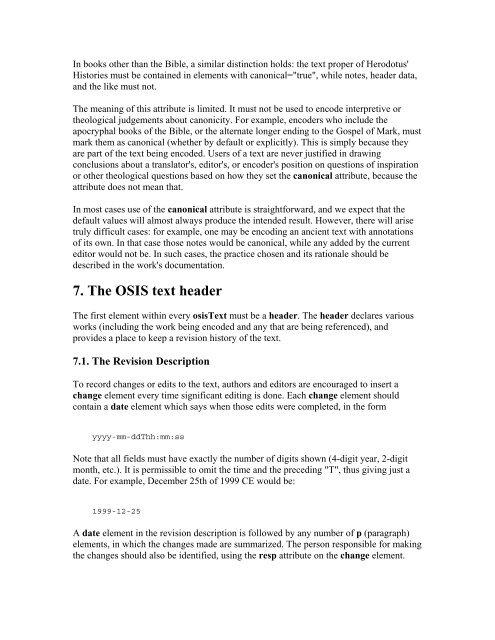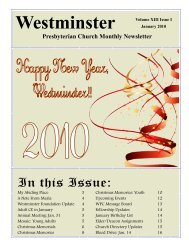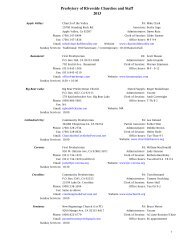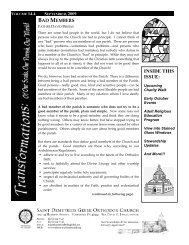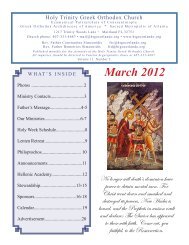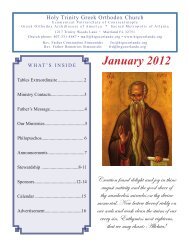OSIS? 2.0.1 User's Manual - Web services are running on AMBIB
OSIS? 2.0.1 User's Manual - Web services are running on AMBIB
OSIS? 2.0.1 User's Manual - Web services are running on AMBIB
You also want an ePaper? Increase the reach of your titles
YUMPU automatically turns print PDFs into web optimized ePapers that Google loves.
In books other than the Bible, a similar distincti<strong>on</strong> holds: the text proper of Herodotus'<br />
Histories must be c<strong>on</strong>tained in elements with can<strong>on</strong>ical="true", while notes, header data,<br />
and the like must not.<br />
The meaning of this attribute is limited. It must not be used to encode interpretive or<br />
theological judgements about can<strong>on</strong>icity. For example, encoders who include the<br />
apocryphal books of the Bible, or the alternate l<strong>on</strong>ger ending to the Gospel of Mark, must<br />
mark them as can<strong>on</strong>ical (whether by default or explicitly). This is simply because they<br />
<str<strong>on</strong>g>are</str<strong>on</strong>g> part of the text being encoded. Users of a text <str<strong>on</strong>g>are</str<strong>on</strong>g> never justified in drawing<br />
c<strong>on</strong>clusi<strong>on</strong>s about a translator's, editor's, or encoder's positi<strong>on</strong> <strong>on</strong> questi<strong>on</strong>s of inspirati<strong>on</strong><br />
or other theological questi<strong>on</strong>s based <strong>on</strong> how they set the can<strong>on</strong>ical attribute, because the<br />
attribute does not mean that.<br />
In most cases use of the can<strong>on</strong>ical attribute is straightforward, and we expect that the<br />
default values will almost always produce the intended result. However, there will arise<br />
truly difficult cases: for example, <strong>on</strong>e may be encoding an ancient text with annotati<strong>on</strong>s<br />
of its own. In that case those notes would be can<strong>on</strong>ical, while any added by the current<br />
editor would not be. In such cases, the practice chosen and its rati<strong>on</strong>ale should be<br />
described in the work's documentati<strong>on</strong>.<br />
7. The <str<strong>on</strong>g>OSIS</str<strong>on</strong>g> text header<br />
The first element within every osisText must be a header. The header decl<str<strong>on</strong>g>are</str<strong>on</strong>g>s various<br />
works (including the work being encoded and any that <str<strong>on</strong>g>are</str<strong>on</strong>g> being referenced), and<br />
provides a place to keep a revisi<strong>on</strong> history of the text.<br />
7.1. The Revisi<strong>on</strong> Descripti<strong>on</strong><br />
To record changes or edits to the text, authors and editors <str<strong>on</strong>g>are</str<strong>on</strong>g> encouraged to insert a<br />
change element every time significant editing is d<strong>on</strong>e. Each change element should<br />
c<strong>on</strong>tain a date element which says when those edits were completed, in the form<br />
yyyy-mm-ddThh:mm:ss<br />
Note that all fields must have exactly the number of digits shown (4-digit year, 2-digit<br />
m<strong>on</strong>th, etc.). It is permissible to omit the time and the preceding "T", thus giving just a<br />
date. For example, December 25th of 1999 CE would be:<br />
1999-12-25<br />
A date element in the revisi<strong>on</strong> descripti<strong>on</strong> is followed by any number of p (paragraph)<br />
elements, in which the changes made <str<strong>on</strong>g>are</str<strong>on</strong>g> summarized. The pers<strong>on</strong> resp<strong>on</strong>sible for making<br />
the changes should also be identified, using the resp attribute <strong>on</strong> the change element.


